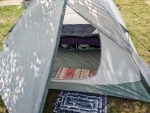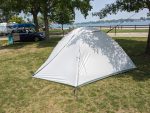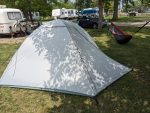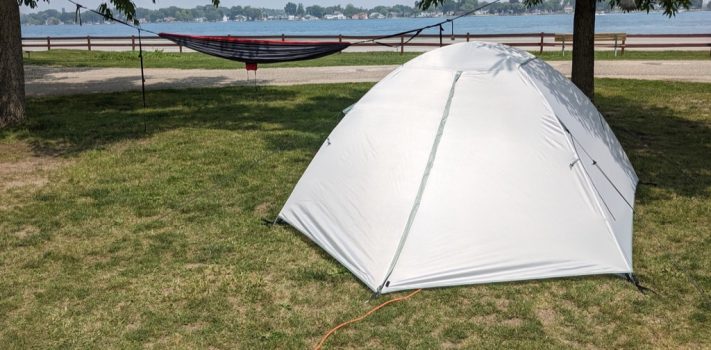Last Spring, my wife “Kari”, my daughter “Rivka”, and I were doing some initial planning for our summer camping excursions. In the course of that planning, we begin to discuss my tent. Rivka said that she wanted to borrow the old tent for a solo excursion that she had planned. I was not 100% comfortable with that idea.
The tent had frankly seen better days. I was well acquainted with its quirks, foibles, flaws, and tricks. With that knowledge, I felt like I could safely use the tent for another season. But I just did not feel that I could trust the tent to effectively protect Rivka when she was off all by her lonesome. She just did not know that sly and treacherous adversary as well as I did. I had visions of mended parts failing and littering the campsite with torn fabric and broken poles, just as a driving rainstorm engulfed Rivka’s campsite.
Soon after this discussion, I received a press release from ALPS Mountaineering about their new Felis 4 Tent. The shorter packing length of the tent suggested easier transport, while the pole clips seemed much more practical for erecting the tent after arrival at the campsite. I contacted ALPS and asked if they could provide me a sample for testing and evaluation. They were kind enough to agree. About a week later I found a package waiting by my door.
First Impressions
I really like the compression sack that the tent comes in. It is compact and well-designed. The durable handle and straps offer a practical alternative to carrying the tent around by the drawstring.
The pitching instructions are printed on a fabric sheet that is sewn into the mouth of the compression sack. It is good to have a durable set of directions secured like this in an easily accessible location. Paper directions may be reduced to a soggy pulp by the rain, lost in the bottom of a bag, or blown away by the wind.
One important line in the directions is, “We recommend that you practice pitching your new tent at home to make sure you are comfortable with the process of setting it up before arriving on your first outing.” That is outstanding advice. Having good equipment is just a start. Knowing how to use it is the real key.
The tent is made of 100% recycled polyester. It is designed for four people. With base dimensions of 7 feet 6 inches by 8 feet 6 inches, those four people better be unusually slender and on very good terms with each other.
The tent has a center height of 4 feet 4 inches. It weighs a total of 8 pounds, 7 ounces. Along with its rain fly and ground stakes, it packs into a compression bag that is 1 foot 11 inches long and 6 inches in diameter. The material is flame-resistant, but will burn if left in continuous contact with a source of flame.
An Un-Asked Question
“The only stupid question. . . .”
“. . . is the one that you neglect to ask.”
I was so interested in the other details about the tent, that I forgot to ask where it is made. You can probably guess where that is. The tent is made in Mainland China.
I generally avoid reviewing products that are made in mainland China. I don’t want to support the economy of a country that is actively trying to undermine my own. But ALPS provided the tent for testing in good faith, so I felt honor-bound to review it. It is not their fault that I forgot to ask an important question before requesting a sample for testing.
Testing
The first major test involved ease of use. I handed the tent to Rivka, and turned her loose. She was able to quickly and easily pitch the tent without any help at all.
A second major test involved comfort. In the summer heat, the light color of the fabric helped to reflect heat, while the doors at opposite ends of the tent allowed for excellent cross-ventilation.
 A third major test involved water tightness. Several days into the first camping trip, a real gully washer of a rainstorm swept through the area during the night. Kari and I were sleeping in our camper. As I looked out the window in the morning at the flooded ground surrounding our campsite, I was certain that Rivka had probably passed a wet and miserable night. I was wrong. The tent kept her perfectly dry and comfortable even in the midst of a torrential downpour.
A third major test involved water tightness. Several days into the first camping trip, a real gully washer of a rainstorm swept through the area during the night. Kari and I were sleeping in our camper. As I looked out the window in the morning at the flooded ground surrounding our campsite, I was certain that Rivka had probably passed a wet and miserable night. I was wrong. The tent kept her perfectly dry and comfortable even in the midst of a torrential downpour.
 A fourth major test involved durability. Most of the components of the tent passed this test, but not the provided stakes. During her solo camping trip, the ground under Rivka’s campsite was quite rocky. She had trouble getting the lightweight stakes that came with the tent into the ground, and bent several of them. She plans to replace all of the supplied stakes with sturdier ones, even though the new stakes will be somewhat heavier.
A fourth major test involved durability. Most of the components of the tent passed this test, but not the provided stakes. During her solo camping trip, the ground under Rivka’s campsite was quite rocky. She had trouble getting the lightweight stakes that came with the tent into the ground, and bent several of them. She plans to replace all of the supplied stakes with sturdier ones, even though the new stakes will be somewhat heavier.
I will now begin to quote Rivka’s own words:
It’s a four-person tent, but I used it for just myself, so there was plenty of room. As one might expect with a backpacking tent, I couldn’t stand upright in it, which made getting dressed a bit of a kneel-and-shuffle activity.
I appreciated the fact that it has two flaps. If I had shared the tent with someone else, the two flaps would’ve made it easy to enter and exit the tent without climbing over anyone.
The first time I used it, during setup I thought I was going to primarily enter and exit through one of the flaps but then decided I liked the opposite direction better. I didn’t have to pull up my stakes and rotate the entire tent, which was nice.
I also like the mesh “shelf” along the tent ceiling. When camping, I like compartmentalizing items, especially small items, for easy access. During the middle of the night, I don’t want to be fumbling around in a duffle bag for my headlamp or my cell phone or lip balm. So it was nice being able to simply reach up and easily access whatever I needed.
I appreciated the nice margin between the inner and outer shells, especially when it started raining heavily one night. The people in the campers were more worried about me staying dry than I was.
ALPS Mountaineering
ALPS Mountaineering was founded in 1993 by outdoor gear designer Dennis Brune. Mr. Brune had previously worked for Kelty in product development, sales, marketing, and management. His goal was to provide high-quality gear priced for the average outdoorsman.
ALPS is a family business, employing Mr. Brune’s wife, LaRayne, their three children (Brian, Adam and Sarah Kristin), and the spouses of each of their children. It is kind of fun to see all 40 of their employees pictured on their web page, including their administrative assistant, customer service representatives, and warehouse staff.
The name ALPS stands for “Active Lifestyle Products and Services.” They are headquarted in New Haven, Missouri.
Some Tents in the Bible
The earliest Biblical reference to tents dates back to before the flood of Noah. One of Cain’s descendants, Jubal son of Lamech, is referred to as the father of tent-dwelling cattle herders. Later on, Noah himself is recorded as passing out drunk in a tent. Still later, the patriarchs Abraham, Isaac and Jacob lived in tents. When the nation of Israel came out of Egypt, they lived in tents in the wilderness. And God’s symbolic dwelling place with them in the wilderness, the resting place for the ark of the covenant, the tabernacle, was a tent. Achan hid the cursed treasure that he stole from the destruction of Jericho under the floor of his tent, and Jael, the wife of Heber the Kenite, killed the Canaanite general Sisera with a tent stake through his head. The descendants of Jonadab, son of Rechab lived in tents until the Babylonian invasion forced them to seek refuge in the city of Jerusalem. Armies throughout the Old Testament are described as dwelling in tents. For example, when David brought Uriah the Hittite back to Jerusalem to try to cover up David’s sin with Bathsheba, Uriah refused to go to his house while the Army of Israel was out living in tents. And in the New Testament, the Apostle Paul was a tentmaker by trade.
Conclusions
 The ALPS Mountaineering Felis 4 tent provides good protection from the elements, whether those elements are sun or rain. It is easy to pitch, compact to pack, light to carry, well designed, and has some really nice practical amenities. The stakes probably won’t stand up to hard use, but the rest of the tent seems quite durable.
The ALPS Mountaineering Felis 4 tent provides good protection from the elements, whether those elements are sun or rain. It is easy to pitch, compact to pack, light to carry, well designed, and has some really nice practical amenities. The stakes probably won’t stand up to hard use, but the rest of the tent seems quite durable.
The color usually won’t blend well into the surrounding terrain, so it probably won’t work well if you are trying to be inconspicuous. But the light color does reflect the heat well, making the tent more comfortable on warm summer days.
With a price at the time of this writing of $249.99 at alpmountaineering.com, the Felis 4 tent represents a good value for a high-quality four-person backpacking tent.
Disclaimer
ALPS Mountaineering was kind enough to provide me with a sample of their Felis 4 Backpacking Tent for testing and evaluation. I tried not to let their kindness interfere with the objectivity of my review, and I believe that I have succeeded. I did not receive any other financial or other inducement to mention any vendor, product, or service in this article.










